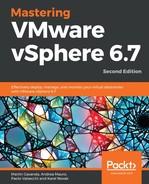The configuration of the FT is a simple process. It is performed on the individual VM level.
As FT traffic might generate a significant amount of bandwidth, it is highly recommended you use a dedicated physical network interface card for such reasons. If you are not able to dedicate a NIC for FT traffic, you should consider using other Quality of Service (QoS) features such as Network IO Control to guarantee specific bandwidth to different traffic types on the shared physical media.
In both cases, prior to configuring the FT on the VM, you need to configure a VMkernel port that will be used for FT traffic and enable the Fault Tolerance logging service on the adapter. Again, it is highly recommended you use a dedicated VMkernel adapter for FT traffic, although you can, of course, enable the Fault Tolerance logging service on the existing adapter:

Once the network configuration is done, VMware vSphere FT can be easily activated or deactivated. To turn on this feature, right-click on the VM, select Fault Tolerance, and Turn On Fault Tolerance:

You need to select which datastore the secondary VM will be stored on as well as which ESXi hypervisor it should run on.
Once the FT is configured, you might notice that the icon of the VM has changed so you can quickly identify those VMs protected by FT:

